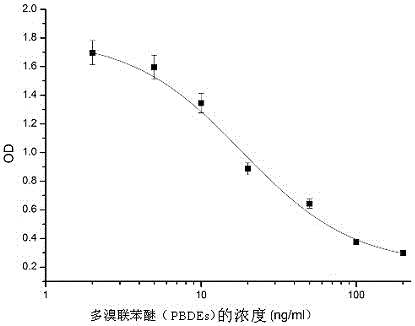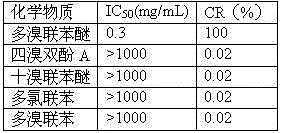PBDE monoclonal antibody hybridoma cell strain and application thereof
A technology of hybridoma cell lines and polybrominated diphenyl ethers, applied in biochemical equipment and methods, instruments, microorganisms, etc., can solve the problems of high cost, inability to realize rapid detection of a large number of samples, cumbersome operation, etc., and achieve good detection sensitivity and specificity Effect
- Summary
- Abstract
- Description
- Claims
- Application Information
AI Technical Summary
Problems solved by technology
Method used
Image
Examples
Embodiment 1
[0022] The preparation of embodiment 1 hybridoma cell line 1A1
[0023] (1) Synthesis of complete antigen
[0024] Dissolve 2,4-dibromophenol (1.04g, 4.13mmol) in 8mL of DMF solution, add NaH (0.2g, 8.33mmol), stir in ice bath for 30min, then let stand to room temperature; after keeping room temperature for 15min, add 3- Bromo-4-fluoronitrobenzene (1.01g, 4.13mmol), heated to reflux at 90°C for 2h; add 10mL of water, wash with CH 2 Cl 2 Extract 4 times with 20 mL each time, extract the organic phase with 25 mL of water, then dry the organic phase with anhydrous magnesium sulfate, and remove the solvent with a rotary evaporator; use silica gel column chromatography to purify, and mix with ether:n-hexane volume ratio of 50:50 Solvent elution gave orange liquid 4'-nitro-2,2',4-tribromodiphenyl ether.
[0025] Using Fe / H + Nitro reduction method, adding 5.0mmol of reducing agent iron powder and 5.0mmol of 4'-nitro-2,2',4-tribromodiphenyl ether into a mixed solvent of ethanol 1...
Embodiment 2
[0034] Example 2 Preparation and identification of polybrominated diphenyl ether monoclonal antibody
[0035] Take 8-10 week-old BALB / c mice, and inject 1 mL of paraffin oil into each mouse; 7 days later, each mouse is injected with 1×10 6 Hybridoma cell line 1A1, ascitic fluid was collected from the seventh day, the ascites fluid was purified by octanoic acid-ammonium sulfate method, and the monoclonal antibody obtained was stored at -20°C.
[0036] Determination of the IC of monoclonal antibodies to polybrominated diphenyl ethers using an indirect competition ELISA 50 It is: 20μg / L, indicating that it has good sensitivity to PBDEs and can be used for the detection of PBDEs in immunoassays.
Embodiment 3
[0037] Application of embodiment 3 polybrominated diphenyl ether monoclonal antibody
[0038] The monoclonal antibody prepared by the hybridoma cell line 1A1 through ascites in vivo was applied to the rapid detection of polybrominated diphenyl ethers, and the specific steps were as follows:
[0039] (1) Coating: Dilute the coated PBDE-OVA with 0.05M pH9.6 carbonate buffer starting from 2μg / mL, 100μL / well, and react at 37°C for 2h.
[0040] (2) Washing: Pour off the solution in the plate, spin dry, and wash 3 times with PBST washing solution, 3 minutes each time.
[0041] (3) Blocking: after pat dry, use CBS blocking solution containing 0.01% gelatin, add 200 μL / well blocking solution, and react at 37°C for 2 hours. Wash and tumble dry for later use.
[0042] (4) Adding samples: Dilute the antiserum starting from 1:1000, add PBS containing 0.01% gelatin to the coated wells of each dilution, 100 μL / well, react at 37°C for 1 hour; after fully washing, add 1:3000 dilution of HR...
PUM
 Login to View More
Login to View More Abstract
Description
Claims
Application Information
 Login to View More
Login to View More - R&D
- Intellectual Property
- Life Sciences
- Materials
- Tech Scout
- Unparalleled Data Quality
- Higher Quality Content
- 60% Fewer Hallucinations
Browse by: Latest US Patents, China's latest patents, Technical Efficacy Thesaurus, Application Domain, Technology Topic, Popular Technical Reports.
© 2025 PatSnap. All rights reserved.Legal|Privacy policy|Modern Slavery Act Transparency Statement|Sitemap|About US| Contact US: help@patsnap.com


